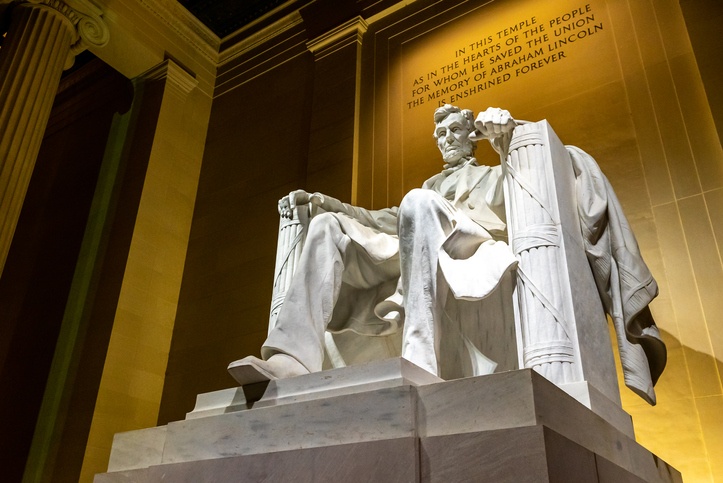Abraham Lincoln’s Gift to Copyright for Photographers

Visiting Scholar and Professorial Lecturer in Law at the George Washington University School of Law; and Assistant Professor at the Southern Illinois University School of Law beginning August 2020. This was written in his personal capacity only.
We don’t typically think of Abraham Lincoln and copyright all that often together – he’s famously the only president to receive a patent, but as far as I’m aware he never registered a copyright (the pre-1870 copyright records are not yet available digitally, but there’s no mention of Lincoln registering a copyright in a transcription of Illinois copyright records from before 1850). However, a mere six weeks before he gave the last full measure of devotion for his country, President Abraham Lincoln signed into law the 1865 Copyright Act, which formally brought photographs into federal copyright protection, and also began the process of bringing copyright to the Library of Congress, which would be completed five years later.
Early copyright statutes attempted to catalog all the possible types of work which could be protected by copyright. As new technologies were developed which allowed for creative and artistic uses the law typically ended up playing catch-up, fitting these new works into old categories, however awkwardly, until Congress and the President updated the law to reflect modern technology. Photography is a prime example of this – the technology was developed decades before the law caught up, The first photographic technology, the daguerreotype, was announced in 1839, but for the first few decades there was no clear way for a photographer to protect their work from copying in the United States.
An 1802 amendment had added “prints” to federal copyright law, and in the 1850s photographers began registering their works pursuant to this provision of the law, with an early example being “stereoscopes” registered by the American Stereoscopic Company in Philadelphia. Also in the 1850s photography became a tool of reportage, as photographs of the Crimean war helped shape the British public’s view of the war there. As candidate for President Lincoln understood the value of photography, distributing campaign buttons with his photograph on them.
As Ted Widmer recounts for the New York Times, Lincoln felt that “Brady and the Cooper Institute made me president.” On February 27, 1860, Candidate Lincoln gave an address at the Cooper Institute (now Union), and earlier that day he had his photograph done by famed photographer Matthew Brady, a likeness that became his way to communicate more broadly than he otherwise could in person. As Widmer observes, Lincoln “intuitively understood that [photographers] were helping him a great deal as he tried to give the Union a face – his own.”
By 1861, Brady was registering his photographs with the US District Court for the District of Columbia, using the decentralized process of the day. However, in place of depositing photographs, that Court’s deposit records show that Brady and other photographers were simply depositing a cardboard stub with the name of the photograph in question to register their copyright. This procedure was clearly a poor fit for copyrights, and as the war dragged on, “[t]he American public’s appetite for candid images of the conflict grew, … photographers sold pictures and stereo cards by the thousands.” Photography was increasingly a career and not just a hobby or curiosity, and a 1802 Act aimed at prints was clearly inadequate.
In 1864, a bill was proposed in Congress to create a complex new scheme for copyright protection of photographs. The bill was never printed and almost entirely forgotten, but I discovered a handwritten draft is at the National Archives, and provided a transcription. In the end the bill was too cumbersome (it would have required each District Court to keep separate records of photographic copyrights, for instance), but by bringing the subject into Congressional debate, Congress was prepared to act quickly once it returned from recess in early 1865 for the “lame duck” session.
On the last day of 1864, President Lincoln named Ainsworth Spofford, previously a Cincinnati newspaperman, the Librarian of Congress. Spofford understood that building a Library of Congress that would be the greatest library in the world was dependent on copyright, and he immediately requested that Congress require deposit of all works registered for copyright with the Library of Congress.
When Congress returned from its recess after the new year, it worked with remarkable speed – the Senate reported a bill out of committee (S. 468) on February 22, 1865, and passed it the next day. The bill included a very simply statutory fix of adding photographs to the subject matter of copyright officially, and also included Spofford’s request of mandatory deposit of all works registered for copyright at the Library of Congress. There have been suggestions that the bill was due to the advocacy of Matthew Brady or his rival Alexander Gardner, but this has not been confirmed. The House of Representatives passed the bill on March 2nd and it went to President Lincoln for his signature the next day, part of a raft of some 50 bills he would eventually sign on that day, unbeknownst to him the last day he would sign a bill into law. We don’t know how carefully Lincoln read the short photographic copyright bill before him, but it’s nice to imagine him having a moment of reflection on how intertwined this bill was with his own career and the conflict that was almost at an end. It was only five years and two weeks since he had sat for a photo at Matthew Brady’s studio, and yet both he and the field of photography had been through decades in that time. President Lincoln signed the bill into law that day, the next-to-last chapter with his signature on it in the Statutes at Large.

